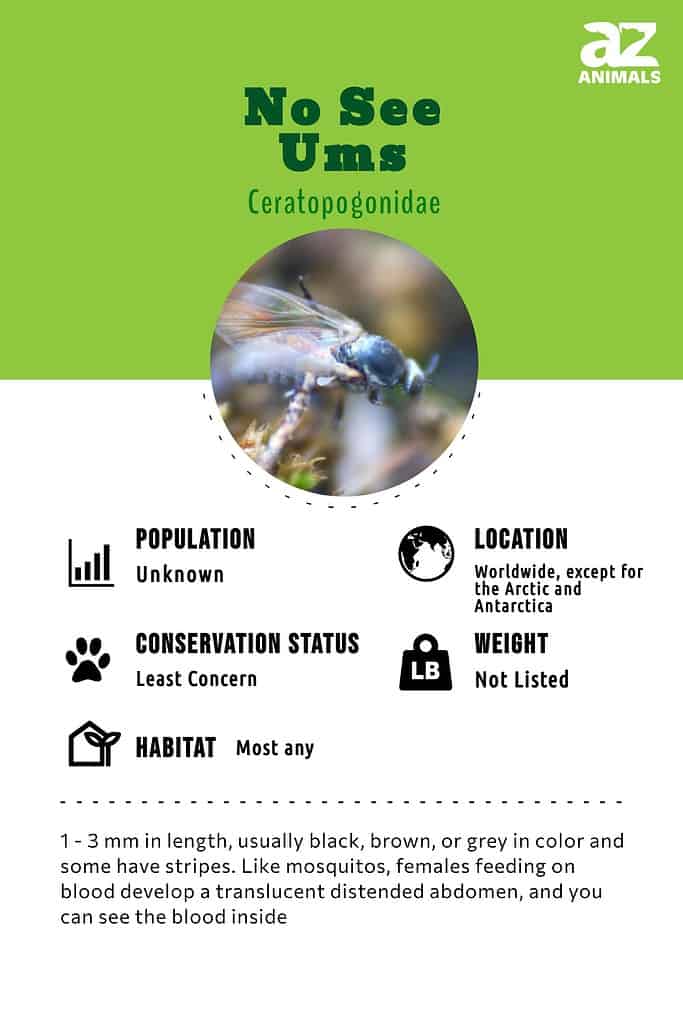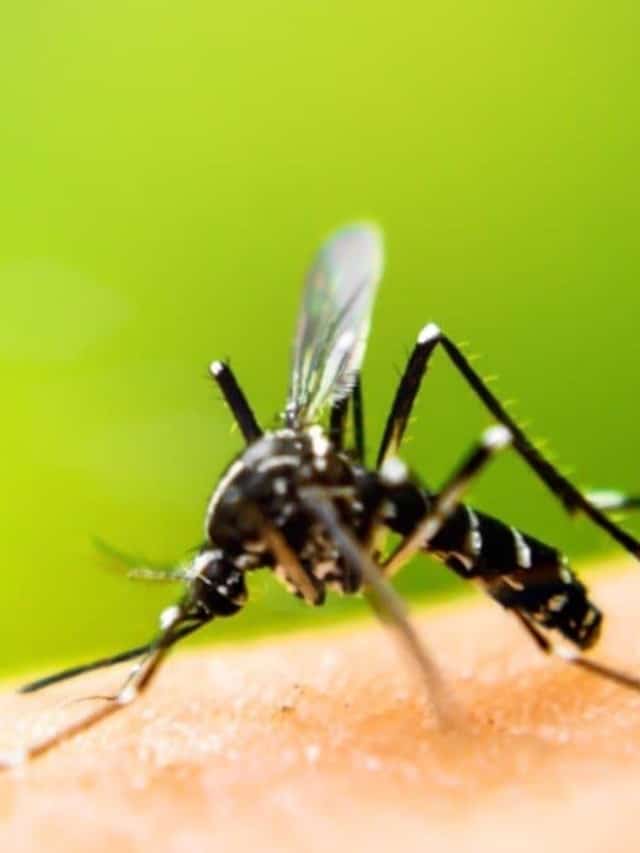No See Ums
There are more than 5,000 species.
Advertisement
No See Ums Scientific Classification
Read our Complete Guide to Classification of Animals.
No See Ums Conservation Status
No See Ums Facts
View all of the No See Ums images!
Have you ever ended up with an itchy bug bite from an insect you did not see? You may have been the victim of a no-see-um!
What are no-see-ums? As the name suggests, they are insects that are so small they are difficult to see. They are biting insects that feed on vertebrate blood or other insects. Can you use nets, screens, or repellents to keep them from getting in houses or biting you? What treatments or home remedies are effective against biting midges? Keep reading to find out where no see ums live, why these bugs bite, and what to do about them.

5 Incredible No See Ums Facts!
No-see-ums can be pesky bugs, but they are also amazing animals.
- There are more than 5,000 species of these insects, and they live in every part of the world except the polar regions. Some species are known from bugs preserved in amber fossils.
- No see ums are holometabolous, meaning they have a complete metamorphosis with four distinct life stages, just like a butterfly. These include egg, larva, pupa, and the mature imago or adult.
- If you like chocolate, thank a no see um! Nectar is a major food source for all of these insects, but in some places, they are a major pollinator of the cocoa bean.
- No see ums have a life cycle of up to six weeks. About 28 days are spent inside the egg.
- These insects have special mouthparts designed for cutting skin. They also inject saliva under the skin, which causes blood to pool there. That makes it easier for the insect to drink the blood, but it also causes an itchy allergic reaction!

The No See Um (Ceratopogonidae) biting fly seated on a plant. The females are blood-sucking insects.
©Maximillian cabinet/Shutterstock.com
Species, Types, and Scientific Names
These insects are commonly called biting midges, punkies, biting gnats, sand flies, or sand fleas. They are a family of flies called Ceratopogonidae. Their superfamily is Chironomoidea, Infraorder Culicomorpha. This infraorder also includes mosquitos. They are of the suborder Nematocera and the order Diptera. Their class is Insecta, the insects; phylum Arthropoda, invertebrates with an exoskeleton; and kingdom Animalia, the animals.
There are more than 5,000 species in the Ceratopogonidae family, divided among numerous genera. The scientific names of each individual species consist of the genera and species designation. A few common species’ scientific names include:
- Culicoides sonorensis.
- Bezzia nobilis, which feeds on mosquito larvae.
- Leptoconops torrens, native to California in the United States.
- Archiaustroconops besti is the oldest species, having been around for at least 142 million years.
Appearance
These insects are tiny, generally ranging from one to three millimeters in length. They are true insects. Noseeums have three body segments – a head, thorax, and abdomen – six legs, and wings. They are usually black, brown, or grey in color. Some have stripes. Like mosquitos, females feeding on blood develop a translucent distended abdomen, and you can see the blood inside.
Noseeums are distinguished from other small flies by a number of characteristics. They have hard structures called sclerites on their heads, and they have mouthparts specifically designed for cutting skin. The larvae of some species can be identified by their prolegs.

No See Ums have hard structures called sclerites on their heads, and they have mouthparts specifically designed for cutting skin.
©auimeesri/Shutterstock.com
Habitat
No see ums can be found in almost every part of the world. The only exceptions are the Arctic and Antarctic, where the extreme temperatures are too cold for noseeums to live.
Diet
The diets of no see ums depend on the species, age, and sex of the individual. Food sources may include nectar, animal blood, or insects.
What Eats Them?
Larger insects and birds may catch and eat no see ums. They are also preyed upon by carnivorous plants, such as the sticky penstemon or beardtongue.

©Jamierpc/Shutterstock.com
What Do They Eat?
Baby no see ums, called larvae, are both aquatic and terrestrial. This means they spend time in water and on land. As such, they often eat algae and fungi. They also need ample moisture to grow.
Similar to mosquitos, both the males and females of the species feed on nectar from flowers. In fact, nectar is their favorite food! In some tropical regions, no see ums are cocoa bean pollinators. This sweet liquid does not contain enough protein to help the female produce eggs, however.
To fill the deficit, the females of most species feed on vertebrate blood. Their mouthparts are designed for cutting the skin. This results in painful bites and itchy lesions on the host’s skin.
A few species prey on other insects rather than on human or animal blood. Interestingly, some species hunt mosquito larvae. At least one species eats only nectar.
History and Evolution
No see ums and similar insects have evolved in a way that allows them to survive by striking their prey without notice. Their diminutive size gives them an advantage in the wild that allows them to feed and avoid detection, while other similar blood-sucking insects might be warded off and find a harder time accessing a host.
Prevention: How to Get Rid Them
No see ums are small enough to pass through window screens and some insect nets, thus getting in houses. They can be repelled using insect repellents such as DEET, eucalyptus oil, Icaridin, or picaridin. Insecticides and even specific bacteria have been used to keep their populations in check.
View all 65 animals that start with NNo See Ums FAQs (Frequently Asked Questions)
How Many Legs Do No See Ums Have?
No see ums are true insects. Like all insects, they have exactly six legs.
How Do You Identify No See Ums?
No see ums look like small flies. They can be differentiated from other biting flies by their species skin-cutting mouthparts and by sclerites, or hardened structures, on their heads.
No see ums like to travel in groups, and receiving multiple bites is the surest way to identify a swarm of no see ums.
What Are No See Ums Attracted To?
No see ums are attracted to carbon dioxide, a gas exhaled by the creatures they bite. Sometimes, people use carbon dioxide to attract and exterminate large numbers of no see ums.
No see ums like long grass and non-moving water sources such as puddles or pools. At night, they may gather around artificial lights. They are also attracted to their food sources – their favorite nectar-producing plants or warm-blooded vertebrates to bite.
How Do You Get Rid of No See Ums?
Getting rid of ideal habitat conditions can help get rid of no see ums. Keep grass and shrubbery trimmed, and cover or drain any sources of standing water.
No see ums have a lifecycle of two to six weeks. Sometimes, insecticide poisons are used to disrupt this cycle and kill the no see ums. Historically, the insecticide DDT was used. Today, larvae are sometimes destroyed using commercial preparations of a bacteria called Bacillus thuringiensis israelensis.
As already noted, insect repellents or “bug sprays” can be used to discourage no see ums from landing on and biting you. Screens and nets are generally not effective in preventing these biting midges from getting in houses.
Where Are No See Ums Found?
No see ums can be found all over the world. Only the icy Arctic and Antarctica are not home to no see ums. They may live in cities, in rural areas, or anywhere that has moisture and a food source.
What Time of Day Do No See Ums Come Out?
No see ums love warm weather, so most bites occur in the summertime. But they can be found year-round in tropical and subtropical climates. They are most active at dawn and dusk.
Why Do No See Ums Bite?
No see ums generally eat nectar from plants, but females need extra protein in order to lay eggs. They get this protein from the blood of humans or other animals.
Are No See Ums Dangerous?
Like other blood-sucking insects, no see ums can be vectors or carriers of disease. They have been known to carry Mansonella nematodes, epizootic hemorrhagic disease, arboviruses, bluetongue disease, and African horse sickness.
What Should You Do If You Are Bitten By a No See Um?
No see um bites start out as a small red dot and expand into a welt one to two inches in diameter over the course of several days. Since no see ums travel in groups, you may have clusters of bites. Several home remedies or treatments may help.
As soon as you notice the bites, clean them with soap and water or an antiseptic solution. This clears away the no see ums’ saliva and reduces your risk of getting an infection.
Don’t scratch the bites. Use an anti-itch cream treatment or cold compresses to reduce the itching and swellings. For home remedies, you can also heat water to 180 degrees Fahrenheit, dip a cotton swab in the water, and apply it to the bite. Be careful not to get the water too hot and burn yourself!
If you notice no see ums where you live, prevent bites by using an insect repellent when you go outside.
What are the differences between mosquitoes and no-see-ums?
The key differences between no-see-ums and mosquitoes include size, distribution, appearance, mouthparts, wings, and larvae survival.
What are the differences between chiggers and no-see-ums?
The differences between no-see-ums and chiggers include size, appearance, lifespan, diet, habitat, classification, and reproduction.
What are the differences between pirate bugs and no-see-ums?
The key differences between pirate bugs and no-see-ums include appearance, lifespan, size, diet, lifecycle, predators, body shape, and habitat.
How are no-see-ums and gnats different?
Gnats and no-see-ums are both tiny flies within the family Ceratopogonidae, but no-see-ums are a specific type of gnat. They differ in size, color, wings, diet and mouthpart.
Thank you for reading! Have some feedback for us? Contact the AZ Animals editorial team.
Sources
- Wikipedia, Available here: https://en.wikipedia.org/wiki/Ceratopogonidae
- Mosquito Nix, Available here: https://mosquitonix.com/blogs/news/how-to-treat-no-see-um-bites
- SWAT Mosquito Systems, Available here: https://swatmosquitosystems.com/2019/02/what-exactly-is-a-no-see-um/

















